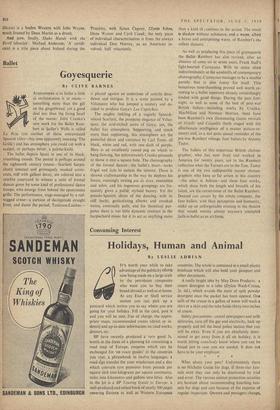Ballet
Goyesquerie
By CLI:VE BARNES
The ballet depicts Spain in one of its black, crumbling moods. The period is perhaps around the • eighteenth century (music—Scarlatti harpsi- chord sonatas) and grotesquely masked aristo- crats, stiff with gallant decay, are ushered into a sombre courtyard to witness a suite of formal dances given by some kind of professional dance troupe, who emerge from behind the eponymous grille. The performance, stage-managed by a red- wigged crone—a cartoon of decrepitude straight from, and damn the period, Toulouse-Lautrec-
is played against an undertone of courtly deca- dence and intrigue. It is a scene painted by a Velazquez who has jumped a century and de- cided to produce Goya's Los Capriehos.
The mighty tinkling of a vaguely Spanish- voiced Scarlatti, the pompous elegance of Velaz- quez, the acid-etched satire of Goya; yes, the ballet has atmosphere. Supporting, and much more than supporting, this atmosphere are the powerful decor and costumes by Carl Toms, all black, white and red, with one dash of purple. Here is an excellently round peg on which to hang dancing, but unfortunatelY Cranko proceeds to shove it into a square hole. The choreography of the formal dances—the ballet's heart—looks frigid and fails to sustain the interest. There is shrewd craftsmanship in the way he deploys his forces, cunningly mixing pas de deux, ensembles and solos, and his ingenious groupings are fre- quently given a pallid, stylised beauty. Yet the pseudo-Spanish idiom of the dancing, with its stiff backs, gesticulating elbows and crooked wrists, eventually palls, and for theatrical pur- Wes there is too little dynamic contrast in the harpsichord music for it to act as anything more than a kind of continuo to the action. The result is shadow without substance, and a waste, albeit a brave and enterprising waste, of Rambert's ex- cellent dancers.
As well as producing this piece of goyesquerie the Ballet Rambert has also revived, after an absence of some six or seven years, Frank Staff's light-hearted Czernyana. With its satire tilted indiscriminately at the windmills of contemporary choreography, Czernyana manages to be a nimble parody that is also funny for itself. This boisterous nose-thumbing proved well worth re- storing to a ballet repertory already astonishingly loaded with good things. During the past fort- night, as well as some of the best of post-war British ballets—including works by Cranko, MacMillan and Norman Morrice, there have been Rambert's own illuminating classic revivals of Giselle and Co. ppelia (both staged with the affectionate intelligence of a master picture-re- storer) and, as a not quite casual reminder of the pre-war Rambert vintage, four ballets by Antony Tudor.
The ballets of this expatriate British choreo- grapher, who has now lived and worked in America for twenty years, are to the Rambert collection what the Turners are to the Tate. Tudor is one of the two indisputable master choreo- graphers who have so far arisen in this country —the other is Ashton—and these four works, which show both the length and breadth of his talent, are the cornerstone of the Ballet Rambert. Danced eon amore by the whole company, the four ballets, with their perception and humanity, make up an unforgettable evening in the theatre that would restore almost anyone's crumpled faith in ballet as an art form.






































 Previous page
Previous page